Gimme a head with hair
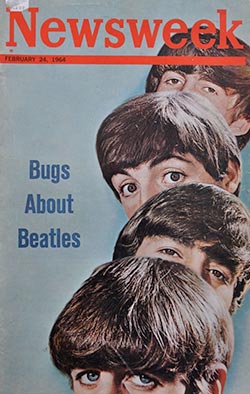
Fifty years after Beatlemania, it’s hard to recapture just how shocked the older generation was by the hair of John, Paul, George, and Ringo.
“Visually,” Newsweek told its readers in February 1964, “they are a nightmare: tight, dandified, Edwardian-Beatnik suits and great pudding bowls of hair.” (The magazine thought even less of their music — “nutty shouts of ‘yeah, yeah, yeah’ … a catastrophe … a preposterous farrago of Valentine-card romantic sentiments.”)
In Ann Arbor, Michigan men shared that Establishmentarian view of the “Beatle cut” for a much longer time than prevailing memories of the 1960s would now have it.
The musical Hair first celebrated the American “freak flag” off-Broadway on Oct. 16, 1967. But if the pages of the Michiganensian are to be trusted, it would be years before U-M saw more than a few men letting their hair truly fly.
1964
Long, beautiful hair
Michiganensian photos of 1964 — the first year of the British Invasion — show men who unanimously shared the sentiments of the Apostle Paul, who had asked the Corinthians: “Doth not nature itself teach you that if a man have long hair it is a shame unto him?” As for the rage for Beatle wigs, the Michigan Daily says: “The wig wearer, you must admit, runs a healthy risk of being mistaken by not only the neighborhood Great Dane, but also by the neighborhood dog catcher.”
1966
Shining, gleaming
A Daily columnist estimates that “the average 1965 Michigan Freshman male has a haircut at least one-third longer than the average Freshman of four years ago. I attribute it to the Beatle influence.” Maybe so — but one-third of a buzz-cut isn’t much. In the yearbook published the following spring, senior men show only the tiniest tendency to outgrow the button-down style of the Kennedy years.
1968
Streaming, flaxen, waxen
In this 1968 montage from the Ensian, the young man at upper-right sports the Bobby Kennedy forelock — an anti-buzz-cut statement that still barely registers above an amplified whisper.
1970
Down to here
Now the break-out begins. On many Michigan men the ears go into hiding, and even among the button-down brigade, the sideburn begins its descent.
1972
Down to there
By now the hair wars are going to court, where judges are asked to rule on whether schools have the right to insist on haircuts. “Nothing is more indicative of the importance currently being attached to hair growth by the general populace,” Justice William O. Douglas writes, “than the barrage of cases reaching the courts evidencing the attempt by one segment of society to control the plumage of another.” There is no restraint, legal or otherwise, at Michigan, where “shoulder-length and longer,” in the lyrics of Hair, has become the new normal. The style is far up, far down, and far out, even among those still willing to wear a tie for the yearbook shoot.
1974
I want hair
The tide has crested. “Times were when getting a haircut was the ultimate gesture of subservience to ‘the system,'” the Daily reports. “Young men on campus would rather risk the uncertain fortunes of a girlfriend’s amateur scissors and comb job than allow some decidedly unhip barber to get his clippers on their lengthy locks.” But now Ann Arbor’s barbers are back in the black: “More and more people in the city are getting their hair clipped, combed, and styled by barbers who have re-educated themselves to current styles” — still long, for sure, but more shapely.
1978
Down to where
Call it the Disco Transition. As collars flare, the sight of ears is once again tolerated.
1984
It stops by itself
Twenty years after Beatlemania, it’s the age of Reagan. It’s after the Afro, but it’s not back to the buzz-cut. And there’s a little more room for the occasional nonconformist. Call it progress.

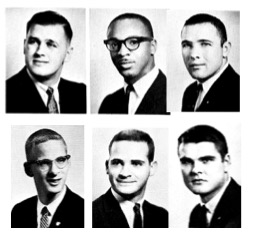
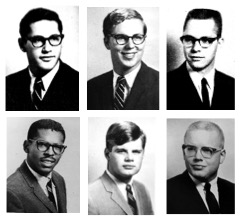
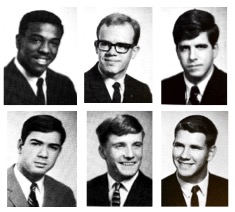

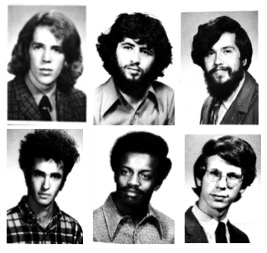
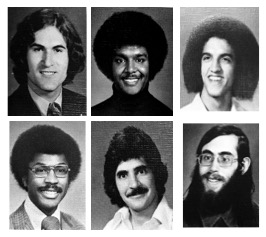
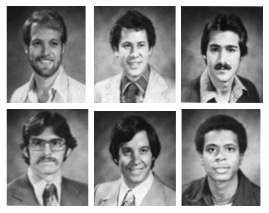



Tracey Becker - 1989
And how about the women
Reply
Steven Youra - 1971
Thanks, James Tobin, for an amusing article. Unfortunately, it is based on a huge “if.” You say that: “In Ann Arbor, Michigan men shared that Establishmentarian view of the ‘Beatle cut’ for a much longer time than prevailing memories of the 1960s would now have it. . . . if the pages of the Michiganensian are to be trusted.” Certainly, the conventional “frat” crowd may have waited until 1972 to grow long hair and expansive “Afros.” But most of us who were called “hippies” (and there were lots of us!) started growing our hair ~1967 (my freshman year) and didn’t see a barber’s chair until the mid-70s. Massive facial hair, too! Few of us bothered to pose for yearbook photos — that would have been far too “Establishment.” So I suggest that you consider running an alternative article based The Michigan Daily archives, where photos of crowds at rock concerts and draft protests would provide ample counter-evidence to the shaky thesis presented here.
Reply
Douglas Cooper - 1966
Long hair in the 60’s was a symbolic rejection of “the establishment’, a sartorial statement in support of ant-war protests, civil rights demonstrations and cultural shifts in the arts, especially popular music. Ann Arbor’s own Bob Seger captured the personal struggle in his song Turn the Page: “All the same old clichés, is that a woman or a man.” As a first year teacher in nearby Clawson, I observed first hand the threat that some perceived to be posed by long hair. The principal marched into my classroom, unannounced, grabbed a sixth grade student with shoulder length hair and departed. When the student returned with a buzz-cut, the entire class felt violated, along with their teacher. In support of that student and the values associated with the counter-culture movement of the 60’s, I have continued to value the individual freedom associated with choosing how to wear one’s hair, although my own choices are being limited by the march of time. As Shakespeare observed in As You Like It: “Last scene of all…sans teeth, sans eyes, sans taste, sans everything.” Someday, possibly, sans hair.
Reply
Kim Clugston - 1966- Sixth grade-Parkland Elementary
Mr. Cooper
I was a student in your 1966 classroom at Parkland Elementary in Clawson. You were an incredible gift to us students that year. You encouraged us to write a report about the economy, geography, and history of Viet Nam. When we realized at the end of the school year that you were eligible for the draft to go to war in the country we just studied, we wrote a letter to the Selective Service in protest. I recently found a copy in my files. I hope life has treated you well over the years. By the way, your hair was fabulous!
Take care,
Kim
Reply
Bill Mosby - 1971, 1977
I remember coming home for Christmas from Ann Arbor in 1969. The first thing my father said to me upon seeing me was “Get a haircut”. These days my hair length is determined primarily by how many weeks pass before I find the time to get it cut. Needless to say, I’m grateful to still have enough left to have to bother.
Reply
Deborah Darin - 1976
Not so many students had photos in the Michiganensian, maybe no one from East Quad! The look on campus in the early seventies was free flowing hair, flannel, and denim.
Reply
William Caruthers - 1977
You nailed it, Deborah! “Flannel shirts and jeans” was the order of the day back then. So much so, I recall a letter or column in the Daily arguing that “uniform” was conforming to the now established college student stereotype, and true nonconformists would wear something/anything else.
Reply
MICHAEL BAILEY - 1973
As a white guy with natural curly hair when I reached Ann Arbor in 1969 my first “rebellious” action was to “let it grow.” My afro was not very well liked by some, read: “Dad,” but to his credit he honored my new freedom; after all wasn’t 18 years of the marine crew-cut long enough. I also suggest general pictures of guys around campus would be more indicative of the changing styles. Very few of us in the early 1970’s posed for the yearbook, or even knew one existed. My afro is gone, but I still only get a haircut when my hair begins to bother me and with less hair comes less concern!
Reply